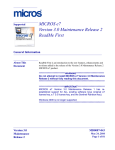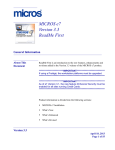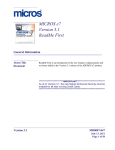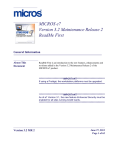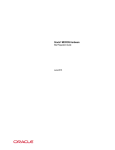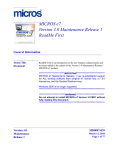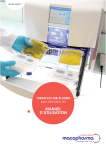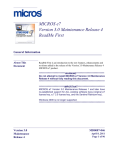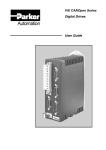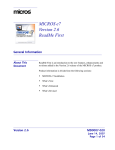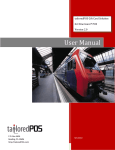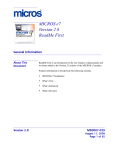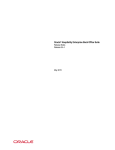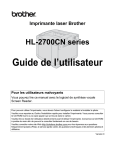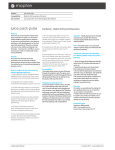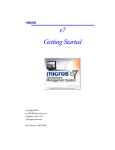Download MICROS e7 Version 4.0 ReadMe First
Transcript
MICROS e7 Version 4.0 ReadMe First General Information About This Document ReadMe First is an introduction to the new features, enhancements and revisions added in the Version 4.0 release of the MICROS e7 product. ****************************IMPORTANT******************************** A new platform version 1.3.1 is available for download from the MICROS Member Services site and must be installed in order to license the mTablet. *************************************************************************** ****************************IMPORTANT******************************** If using a Protégé, the workstation platforms must be upgraded. *************************************************************************** ****************************IMPORTANT******************************** As of e7 Version 3.1, the new feature Enhanced Security must be enabled for all sites running Credit Cards. *************************************************************************** Version 4.0 Revision C February 25, 2015 Page 1 of 60 General Information About This Document Product information is divided into the following sections: MICROS e7 Installation What’s New What’s Enhanced What’s Revised What’s Known Revision C February 25, 2015 Page 2 of 60 Version 4.0 General Information Declarations Declarations © 2014 MICROS Systems, Inc. All rights reserved Warranties Although the best efforts are made to ensure that the information in this document is complete and correct, MICROS Systems, Inc. makes no warranty of any kind with regard to this material, including but not limited to the implied warranties of marketability and fitness for a particular purpose. Information in this document is subject to change without notice. No part of this document may be reproduced or transmitted in any form or by any means, electronic or mechanical, including photocopying, recording, or information recording and retrieval systems, for any purpose other than for personal use, without the express written permission of MICROS Systems, Inc. MICROS Systems, Inc. shall not be liable for errors contained herein or for incidental or consequential damages in connection with the furnishing, performance, or use of this document. Trademarks Adobe FrameMaker is a registered trademark of Adobe Systems Incorporated. The following are either registered trademarks or trademarks of Microsoft Corporation in the U.S. and/or other countries. Operating Systems - Microsoft Windows 8, Microsoft Windows 7, Microsoft Windows Server 2008 R2, Microsoft Windows Server 2008, and Microsoft Windows Server 2003. Database Platforms - Microsoft SQL Server 2008 R2, Microsoft SQL Server 2008 and Microsoft SQL Server 2005. Other products - Microsoft Excel, Microsoft Win32 and Microsoft Windows CE. All other trademarks are the property of their respective owners. Version 4.0 Revision C February 25, 2015 Page 3 of 60 General Information Introduction Introduction MICROS e7 is a robust point-of-sale solution with high quality, reliable and extensive features that the marketplace has grown to expect from MICROS. All of this has been packaged specifically for the independent restaurateur. MICROS e7 is a complete solution that utilizes the revolutionary MICROS Workstation POS terminal platform and over thirty years of MICROS industry leading software solutions. The MICROS e7 user interface offers an intuitive, user-friendly touchscreen design that takes advantage of color, font, and an efficient screen layout to guide servers through the order entry process. The simplicity of the design reduces training time, improves speed of service to the customer, and lowers error rates for daily operations. For more information about the MICROS e7 product, refer to the following resources: e7 Marketing Overview - This manual provides information regarding MICROS, the hospitality industry, features and benefits, sample reports, and a proposed return on investment for MICROS e7. This document is available for download from the MICROS Web site (e7 | Marketing | e7 Marketing Overview). e7 User’s Manual - This manual provides information on how to use the MICROS e7 System, including POS Operations, Manager Procedures, Credit Card Batch, and Reporting. This document is available for download from the MICROS Web site (e7 | e7 [Release Version] | Documentation | e7 User’s Manual). Revision C February 25, 2015 Page 4 of 60 Version 4.0 MICROS e7 Installation Introduction MICROS e7 Installation In order to successfully install and use the MICROS e7 product, the user must upgrade both the PC and workstations to the 2.0 Version of the Microsoft .NET Framework or the .NET Compact Framework respectively. Attempting to upgrade MICROS e7 to Version 4.0 without performing a framework upgrade will cause the installation to fail and an error message to appear. The following error message will appear on a PC: If this occurs, click [OK] to clear the error message and follow the instructions outlined in the MICROS e7 PC Installation section. The following error message will appear when attempting a stand-alone workstation installation: If this occurs, click [OK] to clear the error message and follow the instructions outlined in the Workstation Platform Image section. Version 4.0 Revision C February 25, 2015 Page 5 of 60 MICROS e7 Installation Upgrading From a Non-PCI Compliant Version of Software Upgrading From a Non-PCI Compliant Version of Software Visa established the Payment Card Industry (PCI) Data Security Standard to protect Visa cardholder data—wherever it resides—ensuring that members, merchants, and service providers maintain the highest information security standard. Please see the MICROS e7 PABP Compliance document for the appropriate software version for additional information. Non-PCI compliant versions of MICROS e7 may allow sensitive information, such as credit card numbers, to exist in a non-encrypted format. Such historical data (magnetic stripe data, card validation codes, PINs, or PIN blocks) must be removed. Removal of such data is necessary to ensure the MICROS software upgrade is conducted in a manner that is PCI compliant. The table below lists all of the PCI compliant and non-PCI compliant versions of MICROS e7. Non-PCI Compliant Version 1.0 1.5 1.5 Patch 1 2.0 2.0 Patches 1 & 2 Compliant PCI Versions 2.1 2.1 Patches 1, 2, 3 & 4 2.5 2.6 Patches 1, 2 & 3 2.7 Patches 1 & 2 2.8 3.0 3.1 3.2 3.3 4.0 For information on upgrading a MICROS e7 system from a non-PCI compliant version to a PCI compliant version see the MICROS e7 Version 2.7 Payment Application Best Practices Implementation Guide, MD0007-032 documentation. Revision C February 25, 2015 Page 6 of 60 Version 4.0 MICROS e7 Installation Before You Begin Before You Begin MICROS recommends backing up the MICROS e7 database before performing an update to the system. Follow these steps to back up the database: 1. Open the MICROS e7 Configurator. 2. Select the down arrow on the right-hand side of the screen. 3. A list of available operations will appear. Select Backup the Database. 4. A backup of the database will be written to the \MICROS\e7\DbBackups folder. Version 4.0 Revision C February 25, 2015 Page 7 of 60 MICROS e7 Installation Before You Begin Restore Database Restoring a database is NOT part of the standard MICROS e7 installation process. If for any reason the user needs to restore a database, follow these steps: 1. Open the MICROS e7 Configurator. 2. Select the down arrow on the right-hand side of the screen. 3. A list of available operations will appear. Select Restore the Database. 4. The database will be restored from the \MICROS\e7\DbBackups folder. Revision C February 25, 2015 Page 8 of 60 Version 4.0 MICROS e7 Installation Downloading the MICROS e7 Product Downloading the MICROS e7 Product The MICROS e7 product is available for download from the MICROS Web site. There are several download choices available from the Member Services | Product Support | MICROS Products page. Workstation Platform Image without Protégé support - The platform image will depend on the type(s) of workstation(s) in use at the site. The following images are available if not using a Protégé: Workstation 4. Download this file to extract the platform image for a Workstation 4. Use the e7 | e7 [Release Version] | Workstation 4 Platform Software link to download the ws4_platform_RC_15.2.exe file. Workstation 4 LX. Download this file to extract the platform image for a Workstation 4 LX. Use the e7 | e7 [Release Version] | Workstation 4 LX Platform Software link to download the appropriate WS4LX_platform_RC_2.9_and_BIOS.exe file. Workstation 5. Download this file to extract the platform image for a Workstation 5. Use the e7 | e7 [Release Version] | Workstation 5 Platform Software link to download the appropriate WS5_platform_RC_1.3_and_BIOS.exe file. Workstation 5A. Download this file to extract the platform image for a Workstation 5A. Use the e7 | e7 [Release Version] | Workstation 5A Platform Software link to download the appropriate WS5A_platform_RC_1.2_and_BIOS.exe file. mTablet. Download this file to extract the platform image for an mTablet. Use the e7 | e7 [Release Version] | mTablet Platform Software link to download the appropriate mTablet_platform_version_1.3.1.exe file Workstation Platform Image with Protégé support - The platform image will depend on the type(s) of workstation(s) in use at the site. The following images are available if using a Protégé. Version 4.0 Workstation 4 LX. Download this file to extract the platform image for a Workstation 4 LX. Use the e7 | e7 [Release Version] | Workstation 4 LX Platform Software link to download the appropriate WS4LX_Platform_4.0_and_BIOS.exe file. Revision C February 25, 2015 Page 9 of 60 MICROS e7 Installation Downloading the MICROS e7 Product Workstation 5. Download this file to extract the platform image for a Workstation 5. Use the e7 | e7 [Release Version] | Workstation 5 Platform Software link to download the appropriate WS5_Platform_3.0_and_BIOS.exe file. Workstation 5A. Download this file to extract the platform image for a Workstation 5A. Use the e7 | e7 [Release Version] | Workstation 5A Platform Software link to download the appropriate WS5a_Platform_1.3_and_BIOS.exe file. MICROS e7 Workstation Installation - Download this file if you are installing only to a workstation. Note Ensure that CAL is not enabled when doing standalone installs. Use the e7 | e7 [Release Version] | e7 Workstation 4 Software link to download the e7_ws4_build_4.0.exe file. Use the e7 | e7 [Release Version] | e7 Workstation 4 LX Software link to download the e7_ws4lx_build_4.0.exe file. Use the e7 | e7 [Release Version] | e7 Workstation 5 Software link to download the e7_ws5_build_4.0.exe file. Use the e7 | e7 [Release Version] | e7 Workstation 5A Software link to download the e7_ws5A_build_4.0.exe file. MICROS e7 PC Installation - Download this file if you are installing to a PC. The extracted files can be used to burn a CD or to run the MICROS e7 PC Setup program. Use the e7 | e7 [Release Version] | e7 PC Software link to download the e7_pc_build_4.0.exe file. Revision C February 25, 2015 Page 10 of 60 Version 4.0 MICROS e7 Installation Downloading the MICROS e7 Product Workstation Platform Image The platform image and the installation instructions will vary based on the workstation(s) being used at the site. This section is divided as follows; refer to the appropriate instructions for your workstation version. Workstation 4 Workstation 4 LX Workstation 5 Workstation 5A Workstation 4 Use these instructions to install the Platform Image on a Workstation 4. These steps may also be used to install another CE language platform, such as Chinese, Japanese, or Korean. The MICROS e7 software will not be installed as part of these instructions. A PC or laptop is required to extract the zip (.exe) file and copy the extracted files to the appropriate transfer media, such as a USB thumb drive. 1. Copy the ws4_platform_RC_15.2.exe file from the MICROS Web site to a temporary directory on the PC. 2. Double-click the ws4_platform_RC_15.2.exe file to extract the MICROS e7 files. 3. Enter a directory location where the MICROS e7 files will be extracted (i.e., C:\wsImage). 4. Click Unzip. 5. Click Close. 6. Copy the directory from Step 3 (i.e., C:\wsImage) to a USB thumb drive. Version 4.0 Revision C February 25, 2015 Page 11 of 60 MICROS e7 Installation Downloading the MICROS e7 Product 7. Attach the USB thumb drive to the USB slot on the back of the Workstation 4. 8. Open Windows Explorer on the Workstation. 9. Locate the MICROS e7 software directory (i.e., C:\wsImage) on the USB thumb drive. The USB thumb drive will appear in Explorer as \Hard Disk. The following two sub-directories are available: ..\Standalone CAL Update 1.1.3.55 ..\Standalone Platform Update 15.2 10. From the ..\Standalone CAL Update 1.1.3.55 directory, run StandaloneInstall.exe to upgrade the CAL client software on the workstation. Note Ensure that each workstation has at least 25 MB of free compact flash space before installing the software on the workstation. 11. From the ..\Standalone Platform Update 15.2 directory, run StandaloneInstall.exe to install the 15.2 platform. CAL installs the Windows CE image and reboots the workstation. Workstation 4 LX Use these instructions to install the Platform Image on a Workstation 4 LX. These steps may also be used to install another CE language platform, such as Chinese, Japanese, or Korean. The MICROS e7 software will not be installed as part of these instructions. A PC or laptop is required to extract the zip (.exe) file and copy the extracted files to the appropriate transfer media, such as a USB thumb drive. 1. Copy the WS4LX_Platform_4.0_and_BIOS.exe file from the MICROS Web site to a temporary directory on the PC. Revision C February 25, 2015 Page 12 of 60 Version 4.0 MICROS e7 Installation Downloading the MICROS e7 Product 2. Double-click the WS4LX_Platform_4.0_and_BIOS.exe file to extract the MICROS e7 files. 3. Enter a directory location where the MICROS e7 files will be extracted (i.e., C:\wsImage). 4. Click Unzip. 5. Click Close. 6. Copy the directory from Step 3 (i.e., C:\wsImage) to a USB thumb drive. 7. Attach the USB thumb drive to the USB slot on the back of the Workstation 4 LX. Insert the USB thumb drive into the first USB port on the back of the workstation as indicated below. 8. Open Windows Explorer on the workstation. 9. Locate the MICROS e7 software directory (i.e., C:\wsImage) on the USB thumb drive. The USB thumb drive will appear in Explorer as \Hard Disk. The following two sub-directories are available: Version 4.0 ..\Standalone BIOS Update ..\Standalone Platform Update GR4.0 Revision C February 25, 2015 Page 13 of 60 MICROS e7 Installation Downloading the MICROS e7 Product 10.From the ..\Standalone BIOS Update directory, run StandaloneInstall.exe to upgrade BIOS on the workstation. Note Ensure that each workstation has at least 25 MB of free compact flash space before installing the software on the workstation. 11. From the ..\Standalone Platform Update GR4.0 directory, run StandaloneInstall.exe to install the 4.0 platform. CAL installs the Windows CE image and reboots the workstation. Workstation 5 Use these instructions to install the Platform Image on a Workstation 5. These steps may also be used to install another CE language platform, such as Chinese, Japanese, or Korean. The MICROS e7 software will not be installed as part of these instructions. A PC or laptop is required to extract the zip (.exe) file and copy the extracted files to the appropriate transfer media, such as a USB thumb drive. 1. Copy the WS5_Platform_3.0_and_BIOS.exe file from the MICROS Web site to a temporary directory on the PC. 2. Double-click the WS5_Platform_3.0_and_BIOS.exe file to extract the MICROS e7 files. 3. Enter a directory location where the MICROS e7 files will be extracted (i.e., C:\wsImage). 4. Click Unzip. 5. Click Close. 6. Copy the directory from Step 3 (i.e., C:\wsImage) to a USB thumb drive. Revision C February 25, 2015 Page 14 of 60 Version 4.0 MICROS e7 Installation Downloading the MICROS e7 Product 7. Attach the USB thumb drive to the USB slot on the back of the Workstation 5. Insert the USB thumb drive into the USB port on the back of the workstation as indicated below. 8. Open Windows Explorer on the workstation. 9. Locate the MICROS e7 software directory (i.e., C:\wsImage) on the USB thumb drive. The USB thumb drive will appear in Explorer as \Hard Disk. The following two sub-directories are available: ..\Standalone BIOS Update ..\Standalone Platform Update GR3.0 10. From the ..\Standalone BIOS Update directory, run StandaloneInstall.exe to upgrade BIOS on the workstation. Note Ensure that each workstation has at least 25 MB of free compact flash space before installing the software on the workstation. 11. From the ..\Standalone Platform GR3.0 directory, run StandaloneInstall.exe to install the GR 3.0 platform. CAL installs the Windows CE image and reboots the workstation. Version 4.0 Revision C February 25, 2015 Page 15 of 60 MICROS e7 Installation Downloading the MICROS e7 Product Workstation 5A Use these instructions to install the Platform Image on a Workstation 5A. These steps may also be used to install another CE language platform, such as Chinese, Japanese, or Korean. The MICROS e7 software will not be installed as part of these instructions. A PC or laptop is required to extract the zip (.exe) file and copy the extracted files to the appropriate transfer media, such as a USB thumb drive. 1. Copy the WS5a_Platform_1.3_and_BIOS.exe file from the MICROS Web site to a temporary directory on the PC. 2. Double-click the WS5a_Platform_1.3_and_BIOS.exe file to extract the MICROS e7 files. 3. Enter a directory location where the MICROS e7 files will be extracted (i.e., C:\wsImage). 4. Click Unzip. 5. Click Close. 6. Copy the directory from Step 3 (i.e., C:\wsImage) to a USB thumb drive. Revision C February 25, 2015 Page 16 of 60 Version 4.0 MICROS e7 Installation Downloading the MICROS e7 Product 7. Attach the USB thumb drive to the USB slot on the back of the Workstation 5A. Insert the USB thumb drive into the first USB port on the back of the workstation as indicated below. 8. Open Windows Explorer on the workstation. 9. Locate the MICROS e7 software directory (i.e., C:\wsImage) on the USB thumb drive. The USB thumb drive will appear in Explorer as \Hard Disk. The following two sub-directories are available: ..\Standalone BIOS Update ..\Standalone Platform Update GR1.3 10. From the ..\Standalone BIOS Update directory, run StandaloneInstall.exe to upgrade BIOS on the workstation. Note Ensure that each workstation has at least 25 MB of free compact flash space before installing the software on the workstation. 11. From the ..\Standalone Platform GR1.3 directory, run StandaloneInstall.exe to install the GR1.3 platform. CAL installs the Windows CE image and reboots the workstation. Version 4.0 Revision C February 25, 2015 Page 17 of 60 MICROS e7 Installation Downloading the MICROS e7 Product MICROS e7 Workstation Installation Use these instructions to install the MICROS e7 software on a workstation that has the appropriate Windows CE operating system image already installed. A PC or laptop is required to extract the zip file and copy the extracted files to the appropriate transfer media, such as a USB thumb drive. The zip file will vary depending on the workstation version being used at the site. This section is divided as follows; refer to the appropriate instructions for your workstation version. Workstation 4 Workstation 4 LX Workstation 5 Workstation 5A Note Ensure that CAL is not enabled when doing standalone installs. Workstation 4 1. Copy the e7_ws4_build_4.0.exe file from the MICROS Web site to a temporary directory on the PC. 2. Double-click the e7_ws4_build_4.0.exe file to extract the MICROS e7 files. 3. Enter a directory location where the MICROS e7 files will be extracted. (i.e., C:\e7Software) 4. Click Unzip. 5. Click Close. Revision C February 25, 2015 Page 18 of 60 Version 4.0 MICROS e7 Installation Downloading the MICROS e7 Product 6. Copy the directory from Step 3 (i.e., C:\e7Software) to a USB thumb drive. 7. Attach the USB thumb drive to the USB slot on the back of the workstation. 8. Open Windows Explorer on the workstation. 9. Locate the MICROS e7 software directory (i.e., C:\e7Software) on the USB thumb drive. 10. Run StandAloneInstall.exe. CAL installs the MICROS e7 software and reboots the workstation. Workstation 4 LX 1. Copy the appropriate e7_ws4lx_build_4.0.exe file from the MICROS Web site to a temporary directory on the PC. 2. Double-click the e7_ws4lx_build_4.0.exe file to extract the MICROS e7 files. 3. Enter a directory location where the MICROS e7 files will be extracted. (i.e., C:\e7Software) 4. Click Unzip. 5. Click Close. 6. Copy the directory from Step 3 (i.e., C:\e7Software) to a USB thumb drive. 7. Attach the USB thumb drive to the USB slot on the back of the workstation. 8. Open Windows Explorer on the workstation. 9. Locate the MICROS e7 software directory (i.e. C:\e7Software) on the USB thumb drive. Version 4.0 Revision C February 25, 2015 Page 19 of 60 MICROS e7 Installation Downloading the MICROS e7 Product 10. Run StandAloneInstall.exe. CAL installs the MICROS e7 software and reboots the workstation. 11. If the Protégé will be used, continue with the following steps. If not, the installation is complete. 12. Exit e7. 13. Double-click the e7 standalone install executable again. This will install the files needed for the Protégé and the workstation will reboot. Workstation 5 1. Copy the appropriate e7_ws5_build_4.0.exe file from the MICROS Web site to a temporary directory on the PC. 2. Double-click the e7_ws5_build_4.0.exe file to extract the MICROS e7 files. 3. Enter a directory location where the MICROS e7 files will be extracted (i.e., C:\e7Software). 4. Click Unzip. 5. Click Close. 6. Copy the directory from Step 3 (i.e., C:\e7Software) to a USB thumb drive. 7. Attach the USB thumb drive to the USB slot on the back of the workstation. 8. Open Windows Explorer on the workstation. 9. Locate the MICROS e7 software directory (i.e., C:\e7Software) on the USB thumb drive. 10. Run StandAloneInstall.exe. CAL installs the MICROS e7 software and reboots the workstation. Revision C February 25, 2015 Page 20 of 60 Version 4.0 MICROS e7 Installation Downloading the MICROS e7 Product 11. If the Protégé will be used, continue with the following steps. If not, the installation is complete. 12. Exit e7. 13. Double-click the e7 standalone install executable again. This will install the files needed for the Protégé and the workstation will reboot. Workstation 5A 1. Copy the appropriate e7_ws5A_build_4.0.exe file from the MICROS Web site to a temporary directory on the PC. 2. Double-click the e7_ws5A_build_4.0.exe file to extract the MICROS e7 files. 3. Enter a directory location where the MICROS e7 files will be extracted (i.e,. C:\e7Software). 4. Click Unzip. 5. Click Close. 6. Copy the directory from Step 3 (i.e., C:\e7Software) to a USB thumb drive. 7. Attach the USB thumb drive to the USB slot on the back of the workstation. 8. Open Windows Explorer on the workstation. 9. Locate the MICROS e7 software directory (i.e., C:\e7Software) on the USB thumb drive. 10. Run StandAloneInstall.exe. CAL installs the MICROS e7 software and reboots the workstation. 11. If the Protégé will be used, continue with the following steps. If not, the installation is complete. Version 4.0 Revision C February 25, 2015 Page 21 of 60 MICROS e7 Installation Downloading the MICROS e7 Product 12. Exit e7. 13. Double-click the e7 standalone install executable again. This will install the files needed for the Protégé and the workstation will reboot. MICROS e7 PC Installation With MICROS e7, a PC can be set up to run the MICROS e7 ReportsPlus, Configurator, and Credit Cards modules. To use these applications on a PC, the .NET Framework (Version 2.0 or higher) must be installed prior to the MICROS e7 PC installation. Optionally, the PC may be configured to be a CAL server for the MICROS e7 site so that it can be used to update the workstations with the MICROS e7 workstation software. Note The .NET Framework (Version 2.0 or higher) must be installed on the PC prior to running the MICROS e7 PC setup program. .NET Framework is available for download from Microsoft’s Web site. Firewall Settings If Windows Firewall is enabled during the MICROS e7 setup, the system will automatically configure the firewall exceptions needed for the applications to communicate across the network. When an application is listed on the Exceptions List, Windows overrides the application’s security settings and automatically applies the necessary listening ports. These exceptions include: Revision C February 25, 2015 Page 22 of 60 MICROS CAL Service MICROS SSF UI Launcher (enable if Gift Cards are used) POSMain Version 4.0 MICROS e7 Installation Downloading the MICROS e7 Product If the Windows Firewall is disabled during the MICROS e7 setup and then later enabled after the setup has completed, the user must manually add applications to the Windows Firewall Exceptions List by following the instructions below. Keep in mind that steps may vary slightly depending on the operating system used. To add an application to the Exceptions List: 1. From the PC, navigate to Start | Settings | Control Panel, and select either Security Center or Windows Firewall. 2. Ensure that the Windows Firewall is Enabled. 3. Click the Windows Firewall icon. A Windows Firewall screen will appear. 4. Click the Exceptions tab and add the following programs and services. Version 4.0 MICROS CAL Service MICROS SSF UI Launcher (enable if Gift Cards are used) POSMain (also known as ‘e7’) Remote Assistance Revision C February 25, 2015 Page 23 of 60 MICROS e7 Installation Downloading the MICROS e7 Product To add a program to this list, click the [Add Program] button. The Add a Program dialog box will appear. From here the user can add a program by either: Selecting the appropriate program from the list and clicking [OK], OR Selecting [Browse] and navigating to the file location for the desired program and clicking [Open]. 5. The newly added program will appear in the Exceptions List on the Exceptions tab. Revision C February 25, 2015 Page 24 of 60 Version 4.0 MICROS e7 Installation Downloading the MICROS e7 Product For Windows Server 2003 - 32 bit Extracting the MICROS e7 PC Setup Files Use these instructions to extract the PC Setup zip (.exe) file and install the extracted files to a PC. 1. Copy the e7_pc_build_4.0.exe file from the MICROS Web site to a temporary directory on the PC. 2. Double-click the e7_pc_build_4.0.exe file to extract the MICROS e7 files. 3. Enter a directory location where the MICROS e7 files will be extracted (i.e., C:\e7CD). 4. Click Unzip. 5. Click Close. Note Start the MICROS e7 installation from the directory where you extracted files in the previous steps (i.e., C:\e7CD).Use the instructions below. or Burn the extracted MICROS e7 files onto a CD. Then click e7PcSetup.exe to start the product installation. Installing the MICROS e7 PC Setup Files to a PC Note Once the CAL software is installed on the PC, the system will automatically upgrade each workstation. Ensure that each workstation has at least 25 MB of free compact flash space before installing the software on the PC. 1. Open Windows Explorer on the PC. 2. Locate the MICROS e7 software directory (i.e., C:\e7CD) that you extracted in the previous steps. 3. Run e7PCSetup.exe. Version 4.0 Revision C February 25, 2015 Page 25 of 60 MICROS e7 Installation Downloading the MICROS e7 Product 4. Click [Next] from the MICROS e7 Setup Welcome screen. 5. Review the End User License Agreement, click I Accept the Agreement, and click [Next]. 6. Enter the location where MICROS e7 will be installed. The default destination location is the same as the previously installed version of MICROS e7 or C:\Program Files\MICROS\e7 for a new installation. Click the [Browse] button to select a different destination location. 7. Select the additional tasks to be performed by the MICROS e7 installation and click [Next]. The following actions will automatically be performed: Create shortcut on the desktop - Creates a desktop shortcut for the e7.exe file in the \bin folder. The name of the desktop shortcut is MICROS e7 and the default folder is the \bin folder. Create shortcut in the Start Menu - Creates a selection for MICROS e7 in Start Menu | Programs on the PC. Create shortcut in the Startup folder - Creates a shortcut in the PC’s startup folder for the e7.exe program. Install MICROS CAL Service - Installs the MICROS CAL Service on the PC. If the CAL server is already installed, this choice is greyed out. 8. Click [Finish] to begin installing MICROS e7. Note After the CAL server installation, the workstation operating system images will be automatically updated. If prompted to reboot the PC, please wait until all workstations have finished their CAL upgrade to MICROS e7 Version 4.0. 9. When finished, a prompt will appear indicating that installation is complete. Click [OK]. 10. Start MICROS e7. Revision C February 25, 2015 Page 26 of 60 Version 4.0 MICROS e7 Installation Downloading the MICROS e7 Product 11. If this is a new MICROS e7 installation, enter the Network location ID and Restore the Database via the MICROS e7 Configurator. The Network location ID is used when communicating with the workstations and PC. IMPORTANT: The Network location ID must be the same for every workstation and PC on the network. Note that this entry is case sensitive. If this is a MICROS e7 software upgrade, CAL will update the workstations and MICROS e7 will start automatically. Installing MICROS e7 on the Workstation via CAL Performing a New MICROS e7 Installation Follow the instructions below to install the MICROS e7 application on a workstation via CAL. 1. Navigate to Start | Programs | CAL | Reconfigure CAL. 2. Highlight the CAL Server and click [Next]. Version 4.0 Revision C February 25, 2015 Page 27 of 60 MICROS e7 Installation Downloading the MICROS e7 Product 3. Click [Save]. 4. The workstation will reboot after the files have been installed. 5. Enter the Network location ID. The Network location ID is used when communicating with the workstations and PC. IMPORTANT: Revision C February 25, 2015 Page 28 of 60 Version 4.0 MICROS e7 Installation Downloading the MICROS e7 Product The Network location ID must be the same for every workstation and PC on the network. Note that this entry is case sensitive. Click [OK]. 6. The following error will appear: Need to program an employee and a job to use configurator. Click [OK]. 7. The Configurator opens to the shell database. Version 4.0 Revision C February 25, 2015 Page 29 of 60 MICROS e7 Installation Downloading the MICROS e7 Product 8. The following message appears and a new encryption key must be generated. The key will only need to be generated on one node (any node) and the key will be changed everywhere. Click [OK]. 9. The following prompt appears, instructing the user to navigate to the MICROS e7 Configurator | Restaurant | Credit Cards tab to change the key. Click [OK]. Do not change the encryption key now. IMPORTANT: The installation process must finish and all workstations must be online before generating the key. These instructions will prompt you to generate the key in a later step on page 31. Revision C February 25, 2015 Page 30 of 60 Version 4.0 MICROS e7 Installation Downloading the MICROS e7 Product 10. Select ‘Retrieve the Database.’ 11. Click [Refresh]. 12. Exit the Configurator. 13. Exit MICROS e7 and reboot the workstation. 14. Log in to the MICROS e7 Configurator. Navigate to the MICROS e7 Configurator | Restaurant | Credit Cards tab. 15. Change the encryption key by clicking the [Generate New Key] button. This button will generate a new pass phrase. This operation will fail if there are open checks on the system, or if there are offline workstations. Do not continue until both of these Version 4.0 Revision C February 25, 2015 Page 31 of 60 MICROS e7 Installation Downloading the MICROS e7 Product issues are resolved. If the system satisfies these requirements, the following verification prompt will appear: Click [Yes] to continue, or [No] to stop. 16. The following verification prompt will appear: Click [Yes] to continue, or [No] to stop. 17. The following final verification prompt will appear: Click [Yes] to continue, or [No] to stop. The prompting is intended to ensure that the key is not changed accidentally. Revision C February 25, 2015 Page 32 of 60 Version 4.0 MICROS e7 Installation Downloading the MICROS e7 Product 18. If the key is generated from the PC, an hourglass will appear until the process is complete. If the key is generated from a workstation, an hourglass will appear along with the following dialog box. 19. Once this process is complete, the dialog box will disappear and the hourglass will return to the normal mouse cursor. 20. Click [Save]. Performing a MICROS e7 Upgrade Follow the instructions below to install the MICROS e7 application on a workstation via CAL. 1. After performing the upgrade on the PC, CAL will automatically update the workstation(s). 2. The workstation will reboot after the files have been installed. 3. If upgrading from MICROS e7 v. 2.7 Patch 1 or higher, the MICROS e7 installation process is complete and steps 6–13 are not needed. If upgrading from MICROS e7 v. 2.7 or below, proceed to step 4. Version 4.0 Revision C February 25, 2015 Page 33 of 60 MICROS e7 Installation Downloading the MICROS e7 Product 4. The following message appears and a new encryption key must be generated. The key will only need to be generated on one node (any node) and the key will be changed everywhere. Click [OK]. 5. The following prompt appears, instructing the user to navigate to the MICROS e7 Configurator | Restaurant | Credit Cards tab to change the key. Click [OK]. Do not change the encryption key now. IMPORTANT: The installation process must finish and all workstations must be online before generating the key. 6. Navigate to the MICROS e7 Configurator | Restaurant | Credit Cards tab. 7. Change the encryption key by clicking the [Generate New Key] button. This button will generate a new pass phrase. This operation will fail if there are open checks on the system, or if there are offline workstations. Do not continue until both of these Revision C February 25, 2015 Page 34 of 60 Version 4.0 MICROS e7 Installation Downloading the MICROS e7 Product issues are resolved. If the system satisfies these requirements, the following verification prompt will appear: Click [Yes] to continue, or [No] to stop. 8. The following verification prompt will appear: Click [Yes] to continue, or [No] to stop. 9. The following final verification prompt will appear: Click [Yes] to continue, or [No] to stop. The prompting is intended to ensure that the key is not changed accidentally. Version 4.0 Revision C February 25, 2015 Page 35 of 60 MICROS e7 Installation Downloading the MICROS e7 Product 10. If the key is generated from the PC, an hourglass will appear until the process is complete. If the key is generated from a workstation, an hourglass will appear along with the following dialog box. 11. Once this process is complete, the dialog box will disappear and the hourglass will return to the normal mouse cursor. 12. Click [Save]. Installing Windows Vista Business Edition, Windows 7 Professional 32 bit and 64 bit, Windows 8 - 32 bit and 64 bit, or Windows 8.1 - 32 bit and 64 bit Configuring CAL Optionally, the PC may be configured to be a CAL server for the MICROS e7 site so that it can be used to update the workstations with the MICROS e7 workstation software. If the site is using CAL, then all workstations should be turned off or removed from the network until installation of MICROS e7 Version 3.1 Maintenance Release 1 and any applicable patches are complete on the PC. Once the workstations are turned back on, they will be upgraded automatically. Extracting the MICROS e7 PC Setup Files Follow these instructions to extract the PC Setup zip (.exe) file and install the extracted files to a PC. 1. Copy the e7_pc_build_4.0.exe file from the MICROS Web site to a temporary directory on the PC. 2. Double-click the e7_pc_build_4.0.exe file to extract the MICROS e7 files. Revision C February 25, 2015 Page 36 of 60 Version 4.0 MICROS e7 Installation Downloading the MICROS e7 Product 3. Enter a directory location where the MICROS e7 files will be extracted (i.e., C:\e7CD). 4. Click Unzip. 5. Click Close. Note Start the MICROS e7 installation from the directory where you extracted files in the previous steps (i.e., C:\e7CD).Use the instructions below. or Burn the extracted MICROS e7 files onto a CD. Then click e7PcSetup.exe to start the product installation. Installing the MICROS e7 PC Setup Files to a PC Important! Workstation(s) should now be turned off and not turned back on until AFTER patch installation is complete. 1. Open Windows Explorer on the PC. 2. Locate the MICROS e7 software directory (i.e., C:\e7CD) that you extracted in the previous steps. 3. Run e7PCSetup.exe. 4. If User Access Control (UAC) is enabled, the user will be prompted to allow the MICROS e7 installation. Click Allow. 5. Click [Next] from the MICROS e7 Setup Welcome screen. 6. Review the End User License Agreement, click I Accept the Agreement, and then click [Next]. Version 4.0 Revision C February 25, 2015 Page 37 of 60 MICROS e7 Installation Downloading the MICROS e7 Product 7. Enter the location where MICROS e7 will be installed. Note When installing MICROS e7 on a Windows 7 - 64 bit, Windows 8 - 64 bit system, or Windows 8.1 - 64 bit system, the default destination location is C:\Program Files\(x86)\MICROS\e7. This is the recommended destination. 8. Click [Next]. 9. Select the additional tasks to be performed by the MICROS e7 installation and click [Next]. The following actions will automatically be performed: Create shortcut on the desktop - Creates a desktop shortcut for the e7.exe file in the \bin folder. The name of the desktop shortcut is MICROS e7 and the default folder is the \bin folder. Create shortcut in the Start Menu - Creates a selection for MICROS e7 in Start Menu | Programs on the PC. Create shortcut in the Startup folder - Creates a shortcut in the PC’s startup folder for the e7.exe program. Install MICROS CAL Service - Installs the MICROS CAL Service on the PC. If the CAL server is already installed, this choice is greyed out. 10. Click [Finish] to begin installing MICROS e7. 11. When finished, a prompt will appear indicating that installation is complete. Click [OK]. 12. Start MICROS e7. 13. If this is a new MICROS e7 installation, enter the Network location ID and Restore the Database via the MICROS e7 Configurator. The Network location ID is used when communicating with the workstations and PC. IMPORTANT: The Network location ID must be the same for every workstation and PC on the network. Note that this entry is case sensitive. Revision C February 25, 2015 Page 38 of 60 Version 4.0 MICROS e7 Installation Downloading the MICROS e7 Product If this is a MICROS e7 software upgrade, CAL will update the workstations and MICROS e7 will start automatically. 14. If this is a new MICROS e7 installation or if upgrading from MICROS e7 v. 2.7 or below, you will need to generate an encryption key after the installation is complete. For more information, please see the steps outlined on page 34. Version 4.0 Revision C February 25, 2015 Page 39 of 60 MICROS e7 Version 4.0 What’s New MICROS e7 Version 4.0 What’s New New Features Summarized A new feature is defined as one that provides capabilities that were not available in previous versions of the application. The table below summarizes the new features included in this version. Module Feature TP ID/ CR ID MICROS e7 Configurator Added support for mTablet R-series Screen Orientation 36395/ N/A 41 Peripherals Added support for Scale and Coin Changer with mTablet R-series and mStation 36381/ N/A 42 Added support for Cash Drawers with mTablet R-series and mStation 36392/ N/A 42 Added support for Keyless Licensing for each workstation, PC or device with e7 46644, 59526, 63177/ N/A 42 Printing Added support for mStation connected printers 36387/ N/A 48 Setup Support for Windows 8.1 on PC has been introduced N/A/ N/A 49 Added POS client software installation processes for mTablet R-series 36394, 36409/ N/A 49 Added Support for mTablet Rseries / mStation 22490/ N/A 51 Workstation Revision C February 25, 2015 Page 40 of 60 Page Version 4.0 MICROS e7 Version 4.0 What’s New New Features Detailed MICROS e7 Configurator Added support for mTablet R-series Screen Orientation Target Process ID# 36395 CR ID# N/A The mTablet R-series can be configured to be locked into a specific orientation by a cashier. Note The orientation that is configured indicates the position on the mTablet R-series that will be the reference point (Left, Right, Top, or Bottom). The internal Magnetic Stripe Reader (MSR) is used as the reference point. For example, ‘Landscape Left’ means that the MSR is positioned on the left side when looking at the mTablet R-series. If the user selects ‘Portrait Top’, the MSR is positioned at the top when looking at the mTablet R-series. The following types of orientation are available for selection: Enable/Disable Screen Rotation Rotate Screen These are new buttons that can be configured in the Touchscreens form. Version 4.0 Revision C February 25, 2015 Page 41 of 60 MICROS e7 Version 4.0 What’s New Peripherals Added support for Scale and Coin Changer with mTablet Rseries and mStation Target Process ID# 36381 CR ID# N/A The Interfaces form contains a new field named Com Port Mode, which is used for the scale and coin changer interface. If the mTablet R-series device is always docked with a scale or coin changer, the Com Port Mode field should be set to the default value of 0. If the mTablet R-series device is undocked while the mStation is connected to either a scale or coin changer, the Com Port Mode value should be set to 1. Otherwise, communication issues with these peripherals will occur after docking. Added support for Cash Drawers with mTablet R-series and mStation Target Process ID# 36392 CR ID# N/A With this release, up to two cash drawers are supported for each mStation. An employee can be assigned to a specific cash drawer. Only the employee(s) assigned to a specific cash drawer will be able to access it. When mTablet R-series devices are moved and placed on different mStations, the cash drawer assignments remain with the cash drawer on the mStation that the employee was assigned to. Added support for Keyless Licensing for each workstation, PC or device with e7 Target Process ID# 46644, 59526, 63177 Revision C February 25, 2015 Page 42 of 60 Version 4.0 MICROS e7 Version 4.0 What’s New CR ID# N/A In previous versions of e7, a physical USB key was required to license the product. e7 version 4.0 supports the legacy keys on earlier generation workstations, but has been enhanced so that keyless licensing may be used on any e7 compatible MICROS workstation or PC. The keyless licensing solution introduced in e7 version 4.0 accounts for both of these scenarios. A hardware signature file is created using a tool that is installed with the application software. These signature files are then fed into the keyless licensing tool located on the Member Services section of the MICROS Website. Once key codes are generated, an e-mail notification is sent and the key codes can be entered into the system. Additionally, it is possible to return to the Website to look up the codes again if necessary. The License Key Generator application is now available as a separate package. If you use the standalone license generator, you can run it from a thumb drive, and the .XML file will be placed in the folder with the key generator. The following e7 v4.0 files are included in the .ZIP package: LicenseKeyGenerator.exe MicrosZip.dll TIFUtils.dll This package can be extracted and run on a pre-4.0 e7 workstation, or any workstation that does not have e7. This package can be found on the MICROS Member Services Website. An unlicensed workstation will have full functionality for 45 days when it is new, factory reset, or comes out of a licensed state. A valid license code is required to recover from an expired grace period. Configuration Follow these instructions to generate the .XML file on an mTablet. 1. Navigate to \STORE\Micros\e7\Bin. Version 4.0 Revision C February 25, 2015 Page 43 of 60 MICROS e7 Version 4.0 What’s New 2. Highlight LicenseKeyGenerator.exe, and then click the Generate & Exit or Generate button. On a PC, WS4, WS4LX, WS5, or WS5A navigate to Micros\e7\Bin, highlight LicenseKeyGenerator.exe, and then click the Generate & Exit or Generate button. Revision C February 25, 2015 Page 44 of 60 Version 4.0 MICROS e7 Version 4.0 What’s New 3. If using File Utilities to generate the .XML file, in the Enter Arguments To Pass To ‘LicenseKeyGenerator.exe’ dialog, type the syntax very carefully (see example below), and then click the OK button. The first part of the syntax will be the workstation number followed by the location. The location is the name of the site as it appears in the header of the guest check. This is case sensitive and must be entered exactly as shown in the Header form for the guest check. (Note that this is not the same as a training check header nor the header for a credit card voucher.) Note Version 4.0 If using File Utilities to generate the .XML file, the location name should be enclosed with double quotation marks. If using the License Key Generator on each individual workstation or PC (see screens on next pages), do not use quotation marks around the location name. Revision C February 25, 2015 Page 45 of 60 MICROS e7 Version 4.0 What’s New Figure 1: License Key Generator Run on PC Figure 2: License Key Generator Run on Workstation Revision C February 25, 2015 Page 46 of 60 Version 4.0 MICROS e7 Version 4.0 What’s New 4. After the Generate button is pressed, the .XML file is created in the \Bin folder on each individual workstation or PC. The generated .XML file will have a filename similar to the following convention: • microscafe-0.xml (example of file generated from PC) • microscafe-1.xml (example of file generated from workstation) The number in the .XML filename corresponds to the workstation number, so there may be -1 through -6.xml files. The .XML file contains the unique license code identifier for the workstation device or PC. POS Operations Added Battery and Radio Frequency display elements and warnings for mTablet R-series Target Process ID# 36415 CR ID# N/A Support was added for the display of battery and wireless radio frequency status on the mTablet R-series device. New information box elements show the battery level and radio frequency signal quality. These elements are currently populated only on the mTablet R-series device. Version 4.0 Revision C February 25, 2015 Page 47 of 60 MICROS e7 Version 4.0 What’s New Printing Added support for mStation connected printers Target Process ID# 36387 CR ID# N/A e7 v4.0 supports the use of the following types of printers that are connected directly to the mStation: Serial printers • MICROS 2” Mini printer IDN printers IP printers (managed by mTablet R-series or workstation) Receipts, guest checks, and kitchen orders can all be printed. Mini printer configuration Follow these steps to configure the MICROS 2” Mini printer: 1. Open the MICROS e7 Configurator 2. Go to Workstations/Devices. 3. Click Add. 4. Select Printer from the Device type drop-down. 5. Select Micros Mini from the Printer model drop-down. 6. Select Com 2 from the Connection type drop-down. 7. Select 19200 for the Baud rate drop-down. 8. Select None for the Parity drop-down 9. Select 8 for the Num of Data bits drop-down. Revision C February 25, 2015 Page 48 of 60 Version 4.0 MICROS e7 Version 4.0 What’s New 10. Select 1 for the Num stop bits drop-down. 11. Click Save. Setup Support for Windows 8.1 on PC has been introduced Target Process ID#: N/A CR ID# N/A e7 v4.0 supports the Windows 8.1 operating system running on a PC (32 bit and 64 bit). Added POS client software installation processes for mTablet R-series Target Process ID# 36394, 36409 CR ID# N/A e7 v4.0 POS client software can be installed on the mTablet R-series device from a PC using CAL or from standalone CAL. The POS client software can be installed while the mTablet R-series device is connected to or disconnected from the mStation if running wirelessly. The mTablet R-series has dual Network Interface Cards (NIC): wireless and wired. The wireless NIC works when the mTablet R-series is docked in the mStation and undocked. The wired NIC is only connected when the device is docked in the mStation. Configuration The recommended configuration is to disable the Ethernet adapter and use the wireless adapter if the mTablet R-series device will be used undocked. 1. On the mTablet R-series, navigate to Start | Settings | Network and Dial-up Connections. Version 4.0 Revision C February 25, 2015 Page 49 of 60 MICROS e7 Version 4.0 What’s New 2. Right-click ‘ENET1’ (or press-and-hold) and select the ‘Disable’ menu option. 3. Right-click ‘SDCD40N1’ and ensure the connection is enabled. 4. Navigate to Start | Programs | Laird Connection Manager. 5. Configure a Wi-Fi connection. Note If the mTablet R-series device is moved beyond the range of the wireless connection, it will behave as if it is disconnected from the network. Note If the mTablet R-series device will ONLY be used while docked in the mStation, the wireless adapter can be set to ‘Disable’ and the Ethernet adapter should be enabled. The Ethernet adapter uses the port connection of the mStation. Note New adapters for e7 with the mTablet are located on the MICROS Member Services SVC page at http:// members.micros.com/members/product_support/ micros_products/e7/Corporate/e7_SVCInterfaces.aspx. The following gift card host adapters are included with standalone installs for the mTablet: - iCare - RbsLynk (World Pay) - SVS - Valutec Revision C February 25, 2015 Page 50 of 60 Version 4.0 MICROS e7 Version 4.0 What’s New Workstation Added Support for mTablet R-series / mStation Target Process ID# 22490 CR ID# N/A e7 v4.0 supports the mTablet R-series / mStation, which is the first generation of client workstations from MICROS. The mTablet R-series device can be used in a wireless/mobile configuration, or hard-wired via Ethernet connection to the mStation base unit. Using the mTablet Rseries as a wireless device allows flexibility indoors or out. e7 does not support the stadium version of mTablet R-series. mTablet R-series / mStation General Information 10.1” Liquid Crystal Display (LCD) 1024 x 600 screen resolution i.MX6 dual core processor Integrated MSR Connectivity includes 802.11a/b/g/n dual band capable Wi-Fi and Bluetooth 2.1 The mStation R-series provides full POS connectivity for Ethernet connectivity and peripheral devices when the mTablet R-series device is docked. The mStation is also used to re-charge the mTablet R-series device (in a wireless configuration). Version 4.0 Revision C February 25, 2015 Page 51 of 60 MICROS e7 Version 4.0 What’s New Figure 3 below shows the main operating features of the mTablet Rseries. The Power Button is also used to manually reboot the mTablet Rseries client, if needed. Figure 3: mTablet Operating Features Note: Please refer to the hardware documentation “mTablet/ mStation Setup Guide”, posted on the Hardware Portal at http://portals.micros.com/hardware/HSG/pages/ mTablet%20mStation.aspx. Revision C February 25, 2015 Page 52 of 60 Version 4.0 MICROS e7 Version 4.0 What’s Enhanced What’s Enhanced An enhancement is defined as a change made to improve or extend the functionality of the current MICROS e7 software. To qualify as an enhancement, the change must satisfy the following criteria: The basic feature or functionality already exists in the previous release of the software. The change adds to or extends the current process. This differs from a revision (i.e., a bug fix) which corrects a problem not caught in the previous release of the software. Enhancements Summarized Enhancements Detailed The table below summarizes the enhancement included in this version. Module Enhancement TP ID/ CR ID Reports / Autosequence Reporting of split transactions has been enhanced 63144/ N/A Page 53 Reports / Autosequence Reporting of split transactions has been enhanced Target Process ID# 63144 CR ID# N/A The ReportsPlus check detail for split checks has been enhanced. Split transactions will appear in ReportsPlus with a link To the check receiving the item. Version 4.0 Revision C February 25, 2015 Page 53 of 60 MICROS e7 Version 4.0 What’s Enhanced In a similar way, the check that receives the items will provide a link to the source of those items. The item count and total price of items are also shown on the report. Successive splits will appear on reports so that items split from one check to a second and then a third, etc. can be tracked. Revision C February 25, 2015 Page 54 of 60 Version 4.0 MICROS e7 Version 4.0 What’s Enhanced When splitting a check, the new check will not show tax for the items that are on the check. If the check is service totaled after it is split and more items are added to the check, then the tax of those items will be shown. This enhancement does not alter the current reporting within mymicros.net. Note Version 4.0 Currently, reports related to merged checks do not track many successive merges. This is apparent for items that are split and merged across multiple checks. Also, sharing items is not reported; items will only appear on the original check. Revision C February 25, 2015 Page 55 of 60 MICROS e7 Version 4.0 What’s Revised What’s Revised A revision is defined as a correction made to any existing form, feature, or function currently resident in the MICROS e7 product. To qualify as a revision, the change must satisfy the following criteria: The basic form, feature, or functionality must be part of the previous version of the software. The change must replace the current item or remove it from the application. In addition, all reported issues that are deemed to be BY DESIGN are included in this section as well. These issues will contain the preface BY DESIGN in front of the feature name. Revisions Summarized The table below summarizes the revisions included in this version. Module Peripherals POS Operations Reports / Autosequence Revision C February 25, 2015 Page 56 of 60 Revision BY DESIGN: US Robotics serial modem does not show in CC Batch Utility Diagnostics Credit Cards duplicated from previous day when cash drawer was left open Printing a check to backup printer caused sale to record on both workstation Sales Recording Modules R3 platform caused rendering issues Time period posted lost checks rung on the cusp of time periods advancing Exception error occurred when trying to preview a count sheet TP ID/ CR ID Page 62989/ N/A 57 23829/ 33783 57 29100/ 34164 58 15115/ N/A 31468/ 34284 58 36967/ 34576 59 58 Version 4.0 MICROS e7 Version 4.0 What’s Revised Revisions Detailed Peripherals BY DESIGN: US Robotics serial modem does not show in CC Batch Utility Diagnostics Target Process ID# 62989 CR ID# N/A When attempting to determine the device ID of a US Robotics modem that is connected to an mTablet R-series, the modem does not appear in the CC Batch Utility Diagnostics list of devices. This is due to the mTablet platform.Only COM2, COM6, COM8, and COM9 appear in the list. Therefore, a serial modem cannot be used with the mTablet R-series. POS Operations Credit Cards duplicated from previous day when cash drawer was left open Target Process ID# 23829 CR ID# 33783 Previously, when the cash drawer was left open and the ‘Close Cash Drawer’ dialog appeared, closed checks could not be synchronized on the workstation until the drawer was closed. This caused closed checks that were already batched to be batched again the following day. This issue has been corrected. Now, the User Interface (UI) portion of a sync job will not occur while the ‘Close Cash Drawer’ message appears. Version 4.0 Revision C February 25, 2015 Page 57 of 60 MICROS e7 Version 4.0 What’s Revised Printing a check to backup printer caused sale to record on both workstation Sales Recording Modules Target Process ID# 29100 CR ID# 34164 Previously, when a backup printer was selected for check printing, the sale was recorded on the Sales Recording Module (SRM) of the backup printer. This caused an imbalance between the SRM report and the workstation balance report. This has been corrected. Now, the backup printer check will show the word ‘REIMPRESSION’ at the bottom. The sale will be recorded to the primary SRM, but will not appear on the backup SRM. Reports/Autosequence R3 platform caused rendering issues Target Process ID# 15115 CR ID# N/A Previously, Reports Plus showed hyperlinks at the top of the form on a Workstation 4LX and a Workstation 5 running the new R3 platform. This has been corrected. Time period posted lost checks rung on the cusp of time periods advancing Target Process ID# 31468 CR ID# 34284 Previously, when a check was rung just as the time period advanced to the next hourly bucket, the check information was lost. The Labor Time Period reporting was based on the assumption that time periods would be programmed with the ‘end time’ being inclusive (i.e., an end time of 1:59 AM would mean ending at 2:00 AM). This resulted in discrepancies with the Time Period Sales Report. This has been corrected. The Time Period reporting has been updated to no longer add an extra minute to the end time. Proper time period configuration should be as follows: 1:00PM to 2:00PM, 2:00PM to 3:00PM and so on. Revision C February 25, 2015 Page 58 of 60 Version 4.0 MICROS e7 Version 4.0 What’s Revised Exception error occurred when trying to preview a count sheet Target Process ID# 36967 CR ID# 34576 Previously, when attempting to preview a count sheet that had an inventory item with a unit of measure over 12 characters, e7 stopped and threw an exception. This has been corrected. Version 4.0 Revision C February 25, 2015 Page 59 of 60 MICROS e7 Version 4.0 What’s Known What’s Known What’s Known Summarized What’s Known is defined as what needs to be completed for a successful version upgrade for certain modules. The table below summarizes the known limitation in this version. Module Database What’s Known Detailed Feature Import and Append may result in duplicate object numbers TP ID/ CR ID 70931/ N/A Page 60 Database Import and Append may result in duplicate object numbers Target Process ID# 70931 CR ID# 35561 The Import and Append function does not ensure that each object imported has an object number that is not already in use. For example, if a user imports and appends a Menu Item with object number 9, but an item with object number 9 already exists, Import Append allows that item to be imported anyway. This can cause an issue when Menu Items with barcodes are imported and appended. Because the same Menu Items already exist with barcodes, several of the Menu Items can have duplicate barcodes associated with them. When mymicros.net attempts to parse the MenuItemDef.txt file in order to create the EMSMenueItemDef file to post to the portal, an exception error message appears and the definition packet is not created. This is a known limitation. Revision C February 25, 2015 Page 60 of 60 Version 4.0





























































